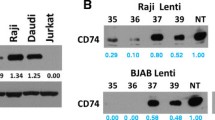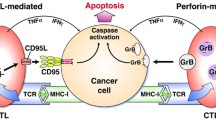Abstract
Studies concerning the expression of the receptor CD95 (Fas) by tumor cells and the role of this protein in apoptosis induced by the effector host cells that bear Fas-ligand are mainly focused on the membrane-bound form of Fas. There are only a few data about the production of the soluble form of Fas by the tumor cells, its role in the interaction with the effector host cells, and the possible changes in the synthesis of this protein during tumor progression. In the present work, three in vivo transformed parental cell lines of different origin and 24 of their variants isolated after a short cycle of natural selection in vivo were studied. It was demonstrated for the first time that: 1) production of the soluble Fas by all selected in vivo variant tumor cell lines increased significantly (2-10-fold) in comparison to the initial (parental) cell lines and did not depend on the origin of the parental lines. At the same time, the expression of the membrane bound form of Fas decreased considerably; 2) variations of the balance between membrane-bound and soluble forms of Fas in selected in vivo variant cells and the expression of the [H2O2 CA + PGES]-phenotype by these cells (this phenotype determines one of the essential mechanisms of the protection of a tumor cell in vivo) possibly represent independent secondary changes acquired during tumor progression in vivo.
Similar content being viewed by others
REFERENCES
Arase, H., Arase, N., and Saito, T. (1995) J. Exp. Med., 181, 1235–1238.
Nagata, S., and Golstein, P. (1995) Science, 267, 1449–1456.
Cascino, I., Fiucci, G., Papoff, G., and Ruberti, G. (1995) J. Immunol., 154, 2706–2713.
Cascino, I., Papoff, G., Eramo, A., and Ruberti, G. (1996) Front. Biosci., 1, 12–18.
Schumann, H., Morawietz, H., Hakim, K., Zerkowski, H. R., Eschenhagen, T., Holtz, J., and Darmer, D. (1997) Biochem. Biophys. Res., 239, 794–798.
Hahne, M., Renno, T., Schroeter, M., Irmler, M., French, L., Bornard, T., McDonald, H. R., and Tschopp, J. (1996) Eur. J. Immunol., 26, 721–724.
Rouvier, E., Luciani, M. F., and Golstein, P. (1993) J. Exp. Med., 177, 195–200.
Restifo, N. (2001) Nature Med., 7, 259.
Schröter, M., Peli, J., Hahne, M., Tschopp, J., and Reichmann, E. (2000) Oncogene, 19, 1794–1800.
Cheng, J., Zhou, T., Liu, C., Shapiro, J. P., Brauer, M. J., Kiefer, M. C., Barr, P. J., and Mountz, J. D. (1994) Science, 263, 1759–1762.
O'Connell, J., O'sullivan, G. C., Collins, J. K., and Shanahan, F. (1996) J. Exp. Med., 184, 1075–1082.
Deichman, G. I. (2000) Biochemistry (Moscow), 65, 78–94.
Deichman, G. I., Matveeva, V. A., Kashkina, L. M., Dyakova, N. A., Uvarova, E. N., Nikiforov, M. A., and Gudkov, A. V. (1998) Int. J. Cancer, 75, 277–283.
Deichman, G. I., Kashkina, L. M., Misenina, O. A., Gorojanskaya, E. G., Nikiforov, M. A., Gudkov, A. V., Dyakova, N. A., Komelkov, A. V., Prilutskaya, M. O., Kushlinsky, N. E., and Tatosyan, A. G. (1996) Int. J. Cancer, 66, 747–752.
Abbasova, S. G., Kushlinsky, N. E., Murashev, A. N., Kostanian, I. A., Obysheva, M. N., Nikogosian, S. O., Britvin, T. A., Bagirova, N. F., Solovyev, Yu. N., Lipkin, V. M., and Trapeznikov, N. N. (1999) Byul. Eksp. Biol. Med., 127, 328–331.
Voller, A., Bidwell, D., and Bartlett, A. (1980) in Manual of Clinical Immunology (Rose, N. R., and Friedman, H., eds.) 2nd ed., American Society of Microbiology, Washington, D.C., pp. 359–371.
Kluchareva, T. E., Matveeva, V. A., and Kuchlinsky, N. E. (1992) Immunol. Lett., 33, 239–246.
Huang, D. C., Hahne, M., Schroeter, M., Frei, K., Fontana, A., Villunger, A., Newton, K., Tschopp, J., and Strasser, A. (1999) Proc. Natl. Acad. Sci. USA, 96, 14871–14876.
Author information
Authors and Affiliations
Corresponding author
Rights and permissions
About this article
Cite this article
Pirogov, A.V., Abbasova, S.G., Dyakova, N.A. et al. Changes in the Balance between Membrane-Bound and Soluble Forms of CD95 (Fas) during Selection of Tumor Cells in vivo. Biochemistry (Moscow) 67, 240–245 (2002). https://doi.org/10.1023/A:1014474316671
Issue Date:
DOI: https://doi.org/10.1023/A:1014474316671




